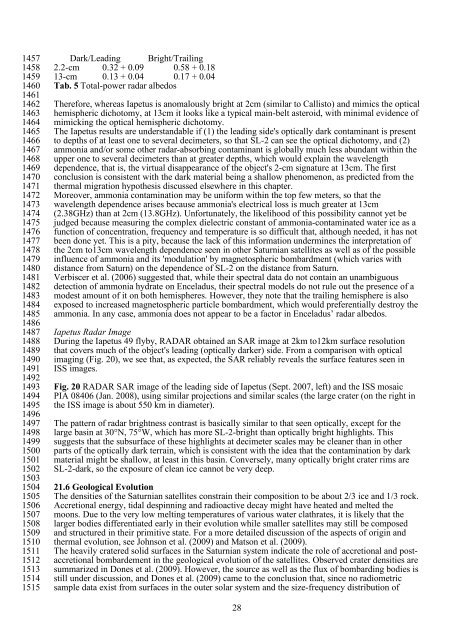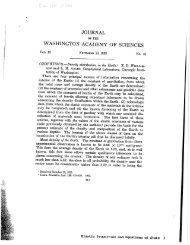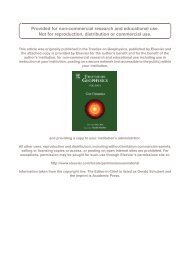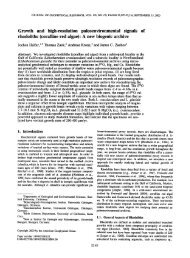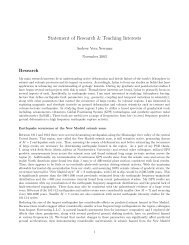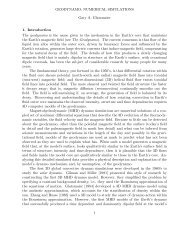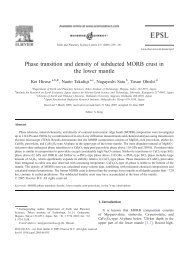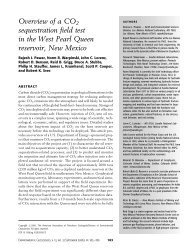Reprint - Earth & Planetary Sciences - University of California, Santa ...
Reprint - Earth & Planetary Sciences - University of California, Santa ...
Reprint - Earth & Planetary Sciences - University of California, Santa ...
You also want an ePaper? Increase the reach of your titles
YUMPU automatically turns print PDFs into web optimized ePapers that Google loves.
1457 Dark/Leading Bright/Trailing<br />
1458 2.2-cm 0.32 + 0.09 0.58 + 0.18<br />
1459 13-cm 0.13 + 0.04 0.17 + 0.04<br />
1460<br />
1461<br />
Tab. 5 Total-power radar albedos<br />
1462 Therefore, whereas Iapetus is anomalously bright at 2cm (similar to Callisto) and mimics the optical<br />
1463 hemispheric dichotomy, at 13cm it looks like a typical main-belt asteroid, with minimal evidence <strong>of</strong><br />
1464 mimicking the optical hemispheric dichotomy.<br />
1465 The Iapetus results are understandable if (1) the leading side's optically dark contaminant is present<br />
1466 to depths <strong>of</strong> at least one to several decimeters, so that SL-2 can see the optical dichotomy, and (2)<br />
1467 ammonia and/or some other radar-absorbing contaminant is globally much less abundant within the<br />
1468 upper one to several decimeters than at greater depths, which would explain the wavelength<br />
1469 dependence, that is, the virtual disappearance <strong>of</strong> the object's 2-cm signature at 13cm. The first<br />
1470 conclusion is consistent with the dark material being a shallow phenomenon, as predicted from the<br />
1471 thermal migration hypothesis discussed elsewhere in this chapter.<br />
1472 Moreover, ammonia contamination may be uniform within the top few meters, so that the<br />
1473 wavelength dependence arises because ammonia's electrical loss is much greater at 13cm<br />
1474 (2.38GHz) than at 2cm (13.8GHz). Unfortunately, the likelihood <strong>of</strong> this possibility cannot yet be<br />
1475 judged because measuring the complex dielectric constant <strong>of</strong> ammonia-contaminated water ice as a<br />
1476 function <strong>of</strong> concentration, frequency and temperature is so difficult that, although needed, it has not<br />
1477<br />
1478<br />
been done yet. This is a pity, because the lack <strong>of</strong> this information undermines the interpretation <strong>of</strong><br />
the 2cm to13cm wavelength dependence seen in other Saturnian satellites as well as <strong>of</strong> the possible<br />
1479 influence <strong>of</strong> ammonia and its 'modulation' by magnetospheric bombardment (which varies with<br />
1480 distance from Saturn) on the dependence <strong>of</strong> SL-2 on the distance from Saturn.<br />
1481 Verbiscer et al. (2006) suggested that, while their spectral data do not contain an unambiguous<br />
1482 detection <strong>of</strong> ammonia hydrate on Enceladus, their spectral models do not rule out the presence <strong>of</strong> a<br />
1483 modest amount <strong>of</strong> it on both hemispheres. However, they note that the trailing hemisphere is also<br />
1484 exposed to increased magnetospheric particle bombardment, which would preferentially destroy the<br />
1485<br />
1486<br />
ammonia. In any case, ammonia does not appear to be a factor in Enceladus’ radar albedos.<br />
1487 Iapetus Radar Image<br />
1488 During the Iapetus 49 flyby, RADAR obtained an SAR image at 2km to12km surface resolution<br />
1489 that covers much <strong>of</strong> the object's leading (optically darker) side. From a comparison with optical<br />
1490 imaging (Fig. 20), we see that, as expected, the SAR reliably reveals the surface features seen in<br />
1491<br />
1492<br />
ISS images.<br />
1493 Fig. 20 RADAR SAR image <strong>of</strong> the leading side <strong>of</strong> Iapetus (Sept. 2007, left) and the ISS mosaic<br />
1494 PIA 08406 (Jan. 2008), using similar projections and similar scales (the large crater (on the right in<br />
1495<br />
1496<br />
the ISS image is about 550 km in diameter).<br />
1497 The pattern <strong>of</strong> radar brightness contrast is basically similar to that seen optically, except for the<br />
1498 large basin at 30°N, 75°W, which has more SL-2-bright than optically bright highlights. This<br />
1499<br />
1500<br />
suggests that the subsurface <strong>of</strong> these highlights at decimeter scales may be cleaner than in other<br />
parts <strong>of</strong> the optically dark terrain, which is consistent with the idea that the contamination by dark<br />
1501 material might be shallow, at least in this basin. Conversely, many optically bright crater rims are<br />
1502<br />
1503<br />
SL-2-dark, so the exposure <strong>of</strong> clean ice cannot be very deep.<br />
1504 21.6 Geological Evolution<br />
1505 The densities <strong>of</strong> the Saturnian satellites constrain their composition to be about 2/3 ice and 1/3 rock.<br />
1506 Accretional energy, tidal despinning and radioactive decay might have heated and melted the<br />
1507 moons. Due to the very low melting temperatures <strong>of</strong> various water clathrates, it is likely that the<br />
1508 larger bodies differentiated early in their evolution while smaller satellites may still be composed<br />
1509 and structured in their primitive state. For a more detailed discussion <strong>of</strong> the aspects <strong>of</strong> origin and<br />
1510 thermal evolution, see Johnson et al. (2009) and Matson et al. (2009).<br />
1511 The heavily cratered solid surfaces in the Saturnian system indicate the role <strong>of</strong> accretional and post-<br />
1512 accretional bombardement in the geological evolution <strong>of</strong> the satellites. Observed crater densities are<br />
1513 summarized in Dones et al. (2009). However, the source as well as the flux <strong>of</strong> bombarding bodies is<br />
1514 still under discussion, and Dones et al. (2009) came to the conclusion that, since no radiometric<br />
1515<br />
sample data exist from surfaces in the outer solar system and the size-frequency distribution <strong>of</strong><br />
28


